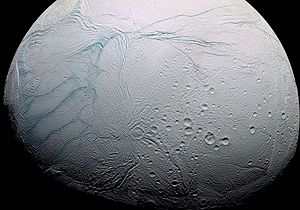Volcanically active worlds: Difference between revisions
imported>Subpagination Bot m (Add {{subpages}} and remove any categories (details)) |
imported>John Stephenson (update) |
||
| Line 4: | Line 4: | ||
In our [[solar system]] there are few known '''volcanically active worlds''' - bodies where openings in the surface [[crust]] allow material to forcefully escape, often in spectacular showers of [[ash]], [[rock (geology)|rock]] or [[gas]]es. To witness such a display you would have to visit parts of [[Earth]], [[Io]], [[Triton]] or, perhaps, [[Enceladus]]. | In our [[solar system]] there are few known '''volcanically active worlds''' - bodies where openings in the surface [[crust]] allow material to forcefully escape, often in spectacular showers of [[ash]], [[rock (geology)|rock]] or [[gas]]es. To witness such a display you would have to visit parts of [[Earth]], [[Io]], [[Triton]] or, perhaps, [[Enceladus]]. | ||
[[Volcanoes]] on Earth are generally found at the boundaries of [[tectonic plate]]s, such as around the [[Pacific Ring of Fire]]. Earth is the only [[planet]] in the solar system which contains these forces - others, such as [[Mars]], are 'dead' worlds where volcanic activity has long since ceased. To witness extra-terrestrial volcanic activity, you would need to visit Io or Triton, [[natural satellite|moon]]s [[orbit]]ing [[Jupiter]] and [[Neptune]] respectively. However, it has recently been suggested that Enceladus, one of [[Saturn]]'s moons, might also be volcanically active - this could explain the [[ice|icy]] [[geyser]]s in the southern region of this tiny world, first observed in 2005 by the ''[[Cassini]]'' probe. If it is true that this little moon is spewing [[water]] into [[space]],<ref>''Science@NASA'': '[http://science.nasa.gov/headlines/y2006/09mar_enceladus.htm Radical! Liquid Water on Enceladus]'. 3rd September 2006.</ref> Enceladus would be added to the growing list of places in the solar system that might be home to some form of [[life]]. To try to resolve these matters, ''Cassini'' | [[Volcanoes]] on Earth are generally found at the boundaries of [[tectonic plate]]s, such as around the [[Pacific Ring of Fire]]. Earth is the only [[planet]] in the solar system which contains these forces - others, such as [[Mars]], are 'dead' worlds where volcanic activity has long since ceased. To witness extra-terrestrial volcanic activity, you would need to visit Io or Triton, [[natural satellite|moon]]s [[orbit]]ing [[Jupiter]] and [[Neptune]] respectively. However, it has recently been suggested that Enceladus, one of [[Saturn]]'s moons, might also be volcanically active - this could explain the [[ice|icy]] [[geyser]]s in the southern region of this tiny world, first observed in 2005 by the ''[[Cassini]]'' probe. If it is true that this little moon is spewing [[water]] into [[space]],<ref>''Science@NASA'': '[http://science.nasa.gov/headlines/y2006/09mar_enceladus.htm Radical! Liquid Water on Enceladus]'. 3rd September 2006.</ref> Enceladus would be added to the growing list of places in the solar system that might be home to some form of [[life]]. To try to resolve these matters, ''Cassini'' set course for a return visit to Enceladus, arriving in March 2008.<ref>''[[New Scientist]]'': '[http://space.newscientist.com/article/mg19526181.500-geyser-teaser-the-moon-that-should-be-colder.html Geyser teaser: the moon that should be colder]'. 25th August 2007. ''Requires subscription for the full article''.</ref> The probe identified organic chemicals, water vapour and higher temperatures than expected in the fissures of the south polar region, and added more evidence that Enceladus may harbour liquid water beneath the surface.<ref>''Cassini Equinox Mission'': '[http://saturn.jpl.nasa.gov/news/newsreleases/newsrelease20080326 Cassini tastes organic material at Saturn's geyser moon]'. 26th March 2008.</ref> | ||
==Footnotes== | ==Footnotes== | ||
{{reflist|2}} | |||
==See also== | ==See also== | ||
*[[Geophysics]] | *[[Geophysics]] | ||
Revision as of 21:55, 16 May 2009

In our solar system there are few known volcanically active worlds - bodies where openings in the surface crust allow material to forcefully escape, often in spectacular showers of ash, rock or gases. To witness such a display you would have to visit parts of Earth, Io, Triton or, perhaps, Enceladus.
Volcanoes on Earth are generally found at the boundaries of tectonic plates, such as around the Pacific Ring of Fire. Earth is the only planet in the solar system which contains these forces - others, such as Mars, are 'dead' worlds where volcanic activity has long since ceased. To witness extra-terrestrial volcanic activity, you would need to visit Io or Triton, moons orbiting Jupiter and Neptune respectively. However, it has recently been suggested that Enceladus, one of Saturn's moons, might also be volcanically active - this could explain the icy geysers in the southern region of this tiny world, first observed in 2005 by the Cassini probe. If it is true that this little moon is spewing water into space,[1] Enceladus would be added to the growing list of places in the solar system that might be home to some form of life. To try to resolve these matters, Cassini set course for a return visit to Enceladus, arriving in March 2008.[2] The probe identified organic chemicals, water vapour and higher temperatures than expected in the fissures of the south polar region, and added more evidence that Enceladus may harbour liquid water beneath the surface.[3]
Footnotes
- ↑ Science@NASA: 'Radical! Liquid Water on Enceladus'. 3rd September 2006.
- ↑ New Scientist: 'Geyser teaser: the moon that should be colder'. 25th August 2007. Requires subscription for the full article.
- ↑ Cassini Equinox Mission: 'Cassini tastes organic material at Saturn's geyser moon'. 26th March 2008.